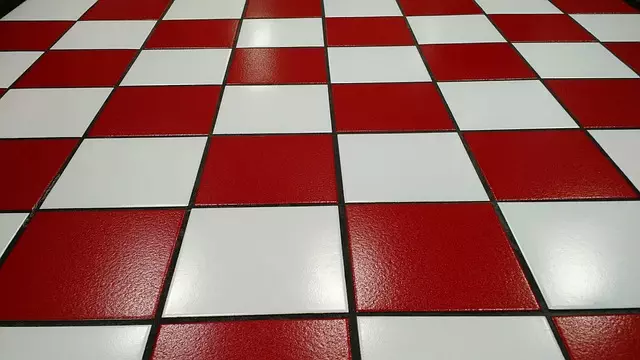Maintaining clean grout lines is crucial for preserving the aesthetics of tiled surfaces. Over time, grout can become discoloured due to spills, dirt, mold, and improper sealing. Effective stain removal requires the right tools and cleaning solutions. Start with a high-quality grout brush and test any cleaner in a small area. For mild stains, use warm water and mild detergent; tougher cases may need specialized grout cleaners or baking soda paste. Regular cleaning with non-harsh chemicals and sealing provides extra protection. Promptly addressing spills reduces the risk of permanent staining. If severe discoloration or damage persists, consult professionals for tailored services. Using natural cleaners like baking soda and vinegar can help maintain grout lines' health while enhancing visual appeal.
Grout lines, the delicate lines that define and separate tiles in your home’s flooring or walls, are not just functional; they add aesthetic beauty. However, these lines can be prone to stains from everyday wear and tear. Understanding grout line protection and cleaning is essential for maintaining the freshness of your space. This article delves into common stain types, effective cleaning tools, step-by-step guides, preventive measures, and when to seek professional help, providing a comprehensive guide on how to remove stains from grout lines.
Understanding Grout Lines and Their Significance

Grout lines are the narrow spaces between tiles, typically filled with a special cement-based material called grout. These lines serve several crucial purposes in any flooring or tiling project. Firstly, they ensure that individual tiles stay in place and do not shift, preventing potential trip hazards and damage to the surface. Secondly, grout lines allow for the effective removal of water and dirt, keeping the area clean and reducing the risk of mould and mildew growth. Properly maintained grout lines contribute to the overall aesthetics of a space, enhancing its visual appeal.
Over time, grout lines can become discoloured and stained due to various factors such as spills, foot traffic, or environmental exposure. Regular cleaning is essential to maintain their integrity and aesthetic value. One common concern is how to effectively remove stains from grout lines without damaging the surrounding tiles. Using appropriate cleaning solutions and techniques, homeowners and professionals alike can restore the freshness of grout lines, ensuring they remain functional and visually pleasing components of any interior space.
Common Stains on Grout Lines: Causes and Types

Grout lines, often overlooked, can accumulate various stains over time, impacting the overall aesthetics of your tiled surfaces. Understanding the common causes and types of grout stains is the first step in effective removal and maintenance. These stains can result from a range of factors such as spilled liquids, dirt, dust, mold, mildew, and even improper sealing or aging.
One of the most prevalent stain types is water-based, often left behind by spilled beverages or poorly maintained areas. Oil-based stains, including those from cooking grease, are another common issue. Additionally, grout can darken due to mold or mildew growth, particularly in humid environments. Over time, dirt and dust accumulate, giving rise to yellowing or discolored patches. Proper cleaning and regular sealing can significantly reduce these issues, ensuring your grout lines remain fresh and clean.
Tools and Materials for Effective Cleaning

When it comes to cleaning grout lines, the right tools and materials can make all the difference. For effective stain removal, a few key items are essential. Start with a good quality grout brush, designed specifically for navigating tight spaces and applying cleaner directly to the grout. These brushes often have fine bristles that can penetrate and lift out stubborn stains.
Additionally, invest in a versatile cleaning solution. A combination of water, mild detergent, and vinegar is a popular choice, as it’s effective yet gentle on surfaces. For more persistent stains, consider using specialized grout cleaners or tile and grout strippers, which can dissolve tough residues. Always test any cleaner in a small, inconspicuous area first to ensure it won’t damage the grout or surrounding tiles.
Step-by-Step Guide: Removing Stains from Grout Lines

Removing Stains from Grout Lines: A Step-by-Step Guide
The first step in grout line protection and cleaning is to address any stains present. Begin by sweeping or vacuuming the floor to remove loose dirt and debris. Next, identify the type of stain—whether it’s from mold, mildew, ink, or food—as this will dictate your cleaning approach. For mild stains, a mixture of warm water and mild detergent is effective; apply this solution using a soft-bristled brush or cloth. Let the solution sit for several minutes to loosen the stain before scrubbing gently and rinsing with clean water.
For tougher stains, consider using a grout cleaner or a baking soda paste (made by mixing baking soda with a small amount of water). Apply these directly to the stained area, allow them to soak for 15-30 minutes, then scrub thoroughly with a grout brush or old toothbrush. Rinse well and dry the lines to prevent re-soiling. Regular cleaning and protection will keep grout lines looking fresh and vibrant.
Preventive Measures to Keep Grout Lines Clean

Regular cleaning and maintenance are essential to keep grout lines free from stains and damage. Preventive measures should start with a thorough understanding of material compatibility. Using appropriate cleaning products specifically designed for grout is crucial; avoid harsh chemicals that could cause discoloration or erosion. Regular mopping with a mild detergent and warm water can help remove surface dirt and prevent debris buildup.
Additionally, sealing the grout lines after installation or when necessary can provide an extra layer of protection against moisture and stains. Sealing agents create a barrier, making it easier to clean and maintain the grout’s appearance over time. Remember, prompt action is key; addressing any spills or drops immediately will significantly reduce the risk of permanent staining.
When to Seek Professional Help for Severe Cases

If your grout lines have become severely discolored, damaged, or are home to persistent stains that simply won’t budge with DIY cleaning methods, it might be time to consider professional assistance. Severe cases often require more than just a quick scrub and a grout cleaner; they may involve deep-seated dirt, mold, or even structural issues within the grout itself. A professional cleaning service has the specialized tools and expertise needed to remove stubborn stains from grout lines effectively. They can also identify any underlying problems that might need addressing, ensuring long-lasting results.
Additionally, professionals offer a range of services tailored to different grout types and levels of damage, from simple deep cleaning to complete grout replacement for severely damaged areas. This not only restores the aesthetic appeal of your tiled surfaces but also prevents further deterioration, guaranteeing a fresh and clean look that can last for years to come.
Conclusion: Maintaining the Beauty of Your Grout Lines

Keeping your grout lines clean and stain-free is an essential part of maintaining the beauty of your tile work. Regular cleaning can prevent dirt, grime, and mold from building up, ensuring your tiles remain vibrant and your spaces look pristine. A simple and effective method to remove stains from grout lines is to use a mixture of baking soda and vinegar. This natural cleaning solution is powerful yet gentle on the grout, making it ideal for frequent use.
By consistently cleaning and protecting your grout lines, you can extend the life of your tile work and maintain its aesthetic appeal. It’s a simple task that makes a significant difference in the overall look of any tiled surface, whether in a kitchen, bathroom, or outdoor patio. So, don’t underestimate the power of proper grout maintenance—it’s a key step in keeping your spaces looking their best.



